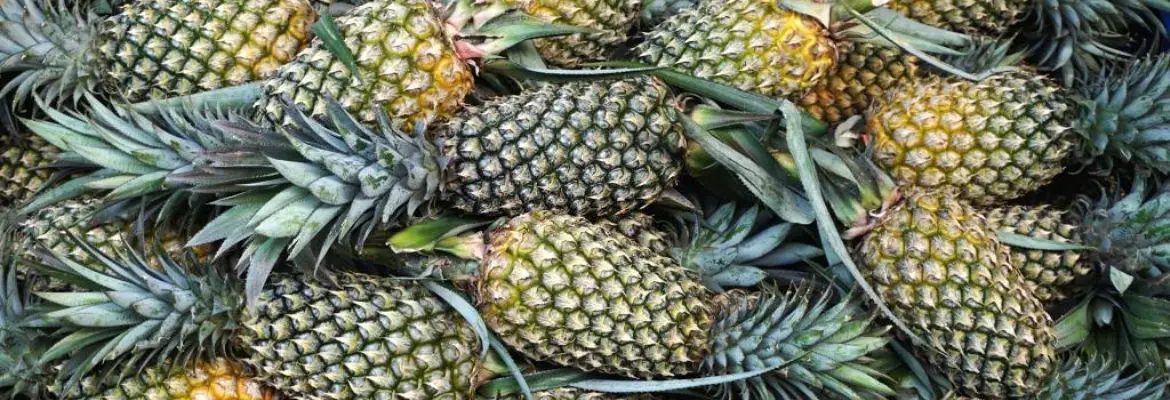Originating in South America, pineapple is a tropical and subtropical fruit. Pineapple is made of many individual berries which grow and group together around a single core. Each pineapple scale / eye is essentially a single berry.
Rich in vitamin C and bromelain, a ripe pineapple can range from greenish yellow to yellow to orangish yellow color ( the more yellowish the color the more riper it is). Pineapple flesh has a very juicy sweet ( hint of tart sometimes) taste and is firm in texture.
Pineapple’s average diameter is about 15 cm (6 inches). Pineapple’s average length can be around 20-30 cm (7.8 – 11.8 inches). Average weight of a pineapple can be 1000 grams ( 1 KG or 2.2 pounds or 35 ounces).

Scientific name of Pineapple
Ananas Comosus
Other names of Pineapple
- Nanas
- Piña
- Ananas
Calories by source in Pineapple
- Calories by carbohydrate in Pineapple = 94%
- Calories by fat in Pineapple = 2%
- Calories by protein in Pineapple = 4%
Fats and Fatty Acid profile of Pineapple
- Polyunsaturated fat (PUFA) in Pineapple = 65%
- Saturated fat (SFA) in Pineapple = 14%
- Monounsaturated fat (MUFA) in Pineapple = 21%
Nutrition facts of Pineapple
*Serving size = 100 grams = 3.55 Ounces = 1/2 cup
*DV= % Daily Value (%DV indicates how much nutrients contribute to a person’s daily diet from a serving of a food. DV assists you in determining whether or not a serving of food is high or low in a particular nutrient.)
| Nutrient | Amount | Unit | DV |
|---|---|---|---|
| Calories | 50 | KCAL | |
| Fat | 0.12 | GRAM | 0% |
| Protein | 0.54 | GRAM | 1% |
| Carbohydrate | 13.12 | GRAM | 5% |
Detailed vitamin profile of Pineapple, vitamin A, vitamin B12, vitamin B6, vitamin C, vitamin D, Folate, Niacin, Thiamin, and Riboflavin is shown in the chart.
Detailed mineral profile of Pineapple, Sodium(Na), Calcium(Ca), Copper(Cu), Iron(Fe), Magnesium(Mg), Selenium(Se), Phosphorus(P), Potassium(K) and Zinc(Zn) is shown the chart.
Check freshness in Pineapple
- Ripe fresh pineapple has dark green leaves
- Brownish leaves at the crown signifies old pineapple
- Ripe pine apple smells sweet (but not fermented)
- The eyes of the pineapple should be bright and shiny
- Avoid pineapples with dry, dark brown and wrinkly eyes
- The bottom of the ripe pineapple will give in to medium pressure
- Some greenish pineapples are still considered as ripe. Please consult you local market seller before purchasing
- Ripe pineapples are heavy and dense for their size
- The size of the eyes from top to bottom of a ripe pineapple is uniform
Availability of Pineapple
- Generally available round the year
- India – Pineapple season ranges from June – November
- USA – Pineapple season ranges from March – July
- Philippines – Pineapple season ranges from May – July
- Indonesia – Pineapple season ranges from December – July
How to store Pineapple
- Fresh pineapple can be stored at room temperature for 2 days
- Storing the pineapple at room temperature will increase the acidity of the fruit but wont increase the sweetness
- Whole uncut pineapple can be stored in refrigerator for 4-5 days
- Cut pineapple pieces can be stored in airtight container for a week
- Pieces of pineapple can be stored in freezer as well in airtight container of zip lock bag for 5-6 months. But, it will lose a little bit of its flavor
Complete nutrition facts of Pineapple
Click on the link HERE to download high quality, high resolution and print ready PDF version of the Pineapple nutrition chart/infographic.


